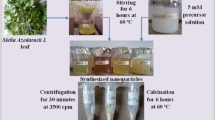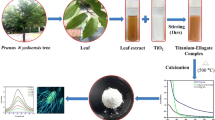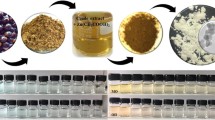Abstract
The seed extract of Abelmoschus esculentus (AE), also known as Okra, was used as a source of reducing and capping agents to synthesized biogenic titanium dioxide nanoparticles (TiO2 NPs) due to its rich flavonoid contents. The synthesized AE-TiO2 nanoparticles were further evaluated by the effect of loading of TiO2 NPs and irradiation time on the photocatalytic degradation of methylene blue dye. The synthesized TiO2 NPs were then characterized by scanning electron microscopy (SEM), X-ray diffraction (XRD), thermogravimetric analysis (TGA), energy dispersive X-ray spectroscopy (EDS), Fourier transformed infrared (FTIR) spectroscopy, Raman spectra, UV–visible spectrophotometry, and particle size distribution (PSD). The findings confirmed the successful synthesis of the spherical anatase phase of TiO2 NPs, as well as the existence of phytochemicals in the extract, which were involved in the capping/stabilization of NPs. The synthesized TiO2 NPs were found to be 60–120 nm in size and almost uniformly distributed throughout the sample. The photocatalytic activity measured in a 300 mL cylindrical photochemical reactor and irradiated with 250 watts UV lamp was investigated based on methylene blue degradation. Effects of irradiation time and catalyst loading were elucidated and correlated with the characteristics of the catalysts. The findings revealed that the synthesized TiO2 NPs were well-dispersed, stable, and could achieve more than 80 % degradation in 240 min of irradiation with 90 mg/L of AE-TiO2 NPs loading compared to only 70 % by the commercial one. These results suggested that AE-TiO2 NPs possesses significant catalytic activity, and the photocatalytic process could be used to degrade, decolorize, and mineralize the methylene blue dye. The polyphenolic tannins present in the extract were the reason behind the desirable characteristics of the nanoparticles and better photocatalytic activity of AE-TiO2 NPs.












Similar content being viewed by others
Data availability
Not applicable.
References
Abdullah AZ, Razali N, Lee KT (2009) Optimization of K/SBA-15 catalyzed transesterification of palm oil using response surface methodology. Fuel Process Technol 90:958–964. https://doi.org/10.1016/j.fuproc.2009.03.023
Ahmad W, Jaiswal KK, Soni S (2020) Green synthesis of titanium dioxide (TiO2) nanoparticles by using Mentha arvensis leaves extract and its antimicrobial properties. Inorg Nano-Metal Chem 50(10):1032–1038. https://doi.org/10.1080/24701556.2020.1732419
Akbari A, Sabouri Z, Hosseini HA, Hashemzadeh A, Khatami M, Darroudi M (2020) Effect of nickel oxide nanoparticles as a photocatalyst in dyes degradation and evaluation of effective parameters in their removal from aqueous environments. Inorg Chem Commun 115:107867. https://doi.org/10.1016/j.inoche.2020.107867
Alessandra D, Massimo L, Ettore N, Eliana BS, Patricia D, Antonello S (2019) Abelmoschus esculentus (L.): Bioactive components’ beneficial properties focused on antidiabetic role for sustainable health applications. Molecules 24:38. https://doi.org/10.3390/molecules24010038
Ambika S, Sundrarajan M (2016) [EMIM] BF 4 ionic liquid-mediated synthesis of TiO2 nanoparticles using Vitex negundo Linn extract and its antibacterial activity. J Mol Liq 221:986–992. https://doi.org/10.1016/j.molliq.2016.06.079
Anupama C, Kaphle A, Udayabhanu Nagaraju G (2018) Aegle marmelos assisted facile combustion synthesis of multifunctional ZnO nanoparticles: study of their photoluminescence, photo catalytic and antimicrobial activities. J Mater Sci Mater Electron 29:4238–4249. https://doi.org/10.1007/s10854-017-8369-1
Anupama RP, Julia G, Shamsheera KO, Abraham J (2019) Bio-inspired green synthesis of zinc oxide nanoparticles using Abelmoschus esculentus mucilage and selective degradation of cationic dye pollutants. J Phys Chem Solids 127:265–274. https://doi.org/10.1016/j.jpcs.2019.01.003
Aravind M, Amalanathan M, Mary MSM (2021) Synthesis of TiO2 nanoparticles by chemical and green synthesis methods and their multifaceted properties. SN Appl Sci 3:409. https://doi.org/10.1007/s42452-021-04281-5
Barkalina N, Charalambous C, Jones C, Coward K (2014) Nanotechnology in reproductive medicine: emerging applications of nanomaterials. Nanomed Nanotechnol Biol Med 10:921–938. https://doi.org/10.1016/j.nano.2014.01.001
Carneiro JT, Savenije TJ, Moulijn JA, Mul G (2011) How phase composition influences optoelectronic and photocatalytic properties of TiO2. J Phys Chem C 115:2211–2217. https://doi.org/10.1021/jp110190a
Chatterjee A, Ajantha M, Talekar A, Revathy N, Abraham J (2017) Biosynthesis, antimicrobial and cytotoxic effects of titanium dioxide nanoparticles using Vigna unguiculata seeds. Mater Lett 9:95–99. https://doi.org/10.25258/ijpapr.v9i1.8047
Duan H, Wang D, Li Y (2015) Green chemistry for nanoparticle synthesis. Chem Soc Rev 44:5778–5792. https://doi.org/10.1039/C4CS00363B
Elmusa F, Aygun A, Gulbagca F, Seyrankaya A, Göl F, Yenikaya C, Sen F (2021) Investigation of the antibacterial properties of silver nanoparticles synthesized using Abelmoschus esculentus extract and their ceramic applications. Int J Environ Sci Technol 18:849–860. https://doi.org/10.1007/s13762-020-02883-x
Fardood ST, Forootan R, Moradnia F, Afshari Z, Ramazani A (2020) Green synthesis, characterization, and photocatalytic activity of cobalt chromite spinel nanoparticles. Mater Res Express 7:015086. https://doi.org/10.1088/2053-1591/ab6c8d
Ganesan S, Babu IG, Mahendran D, Arulselvi PI, Elangovan N, Geetha N, Venkatachalam P (2016) Green engineering of titanium dioxide nanoparticles using Ageratina altissima (L.) King and HE Robines. Medicinal plant aqueous leaf extracts for enhanced photocatalytic activity. Ann Phytomed 5:69–74. https://doi.org/10.21276/ap.2016.5.2.8
Gebre SH, Sendeku MG (2019) New frontiers in the biosynthesis of metal oxide nanoparticles and their environmental applications: an overview. SN Appl Sci 1(8):928. https://doi.org/10.1007/s42452-019-0931-4
Ghaly MY, Jamil TS, El-Seesy IE, Souaya ER, Nasr RA (2011) Treatment of highly polluted paper mill wastewater by solar photocatalytic oxidation with synthesized nano TiO2. Chem Eng J 168:446–454. https://doi.org/10.1109/GTEC.2011.6167693
Ghulam N, Qurat-Ul-Ain, Bilal TM, Khalid NR, Tahir I, Muhammad R, Sajad H, Waseem R, Imran A, Muhammad R (2020) Green synthesis of TiO2 nanoparticles using lemon peel extract: their optical and photocatalytic properties. Int J Environ Anal Chem 0306-7319. https://doi.org/10.1080/03067319.2020.1722816
Jalill RDHA, Nuaman RS, Abd AN (2016) Biological synthesis of titanium dioxide nanoparticles by Curcuma longa plant extract and study its biological properties. World Sci News 49:204–222
Jochebed OG, Jacob KA, Fidelis MK (2017) Total phenol content and antioxidant activity of Okra seeds from different genotypes. Am J Food Nutr 5(3):90-94. https://doi.org/10.12691/ajfn-5-3-2
Karakitsou KE, Verykios XE (1993) Effects of altervalent cation doping of TiO2 on its performance as a photocatalyst for water cleavage. J Phys Chem 97:1184–1189. https://doi.org/10.1021/j100108a014
Khan SU, Al-Shahry M, Ingler WB (2002) Efficient photochemical water splitting by a chemically modified n-TiO2. Science 297:2243–2245. https://doi.org/10.1126/science.1075035
Kuppusamy P, Yusoff MM, Maniam GP, Govindan N (2016) Biosynthesis of metallic nanoparticles using plant derivatives and their new avenues in pharmacological applications–an updated report. Saudi Pharm J 24:473–484. https://doi.org/10.1016/j.jsps.2014.11.013
Mahshid S, Askari M, Ghamsari MS (2007) Synthesis of TiO2 nanoparticles by hydrolysis and peptization of titanium isopropoxide solution. J Mater Process Technol 189:296–300. https://doi.org/10.1016/j.jmatprotec.2007.01.040
Makarov VV, Love AJ, Sinitsyna OV, Makarova SS, Yaminsky IV, Taliansky ME, Kalinina NO (2014) “Green” nanotechnologies: synthesis of metal nanoparticles using plants. Acta Nat 6:35–44
Mohamed K, Zine K, Fahima K, Abdelfattah E, Sharifudin SM, Duduku K (2018) NiO nanoparticles induce cytotoxicity mediated through ROS generation and impairing the antioxidant defense in the human lung epithelial cells (A549): Preventive effect of Pistacia lentiscus essential oil. Toxicol Rep 5:480–488. https://doi.org/10.1016/j.toxrep.2018.03.012
Mohanpuria P, Rana NK, Yadav SK (2008) Biosynthesis of nanoparticles: technological concepts and future applications. J Nanoparticle Res 10:507–517. https://doi.org/10.1007/s11051-007-9275-x
Moradnia F, Saeid TF, Ali R, Samira O, Ilnaz A (2020) Green sol–gel synthesis of CoMnCrO4 spinel nanoparticles and their photocatalytic application. Micro Nano Lett 15(10):674–677. https://doi.org/10.1049/mnl.2020.0189
Nabi G, Raza W, Tahir MB (2020) Green synthesis of TiO2 nanoparticle using cinnamon powder extract and the study of optical properties. J Inorg Organomet Polym Mater 30(4):1425–1429. https://doi.org/10.1007/s10904-019-01248-3
Narayanan KB, Sakthivel N (2011) Green synthesis of biogenic metal nanoparticles by terrestrial and aquatic phototrophic and heterotrophic eukaryotes and biocompatible agents. Adv Colloid Interface Sci 169:59–79. https://doi.org/10.1016/j.cis.2011.08.004
Nitin AM, Vitthal SS, Sandip BK, Gurumeet CW, Maryappa CS (2021) Degradation of dyes using biologically synthesized zinc oxide nanoparticles. Mater Today 37:849–853. https://doi.org/10.1016/j.matpr.2020.06.037
Nnamezie AA, Famuwagun AA, Gbadamosi SO (2021) Characterization of okra seed flours, protein concentrate, protein isolate and enzymatic hydrolysates. Food Prod Process and Nutr 14(3):3013–302. https://doi.org/10.1186/s43014-021-00059-9
Paola AD, Garcia-Lopez E, Marci G, Palmisano L (2012) A survey of photocatalytic materials for environmental remediation. J Hazard Mater 212:3–29. https://doi.org/10.1016/j.jhazmat.2011.11.050
Patidar V, Jain P (2017) Green synthesis of TiO2 nanoparticle using Moringa oleifera leaf extract. Int Res J Eng Technol 4:470–473
Peiro AM, Peral J, Domingo C, Momenech X, Ayllon JA (2011) Low-temperature deposition of TiO2 thin films with photocatalytic activity from colloidal anatase aqueous solutions. Chem Mater 13:2567–2573. https://doi.org/10.1021/cm0012419
Rajabi HR, Khani O, Shamsipur M, Vatanpour V (2013) High performance pure and Fe3+-ion doped ZnS quantum dots as green nano photocatalysts for the removal of malachite green under UV-light irradiation. J Hazard Mater 251:370–378. https://doi.org/10.1016/j.jhazmat.2013.02.007
Ramimoghadam D, Bagheri S, Abd Hamid SB (2014) “Biotemplated synthesis of anatase titanium dioxide nanoparticles via lignocellulosic waste material. Biomed Res Int 205-636https://doi.org/10.1155/2014/205636
Sabouri Z, Akbari A, Hosseini HA, Khatami M, Darroudi M (2020) Egg white-mediated green synthesis of NiO nanoparticles and study of their cytotoxicity and photocatalytic activity. Polyhedron 178:114351. https://doi.org/10.1016/j.poly.2020.114351
Saien J, Ojaghloo Z, Soleymani AR, Rasoulifard MH (2011) Homogeneous and heterogeneous AOPs for rapid degradation of Triton X-100 in aqueous media via UV light, nano titania hydrogen peroxide and potassium persulfate. Chem Eng J 167:172–182. https://doi.org/10.1016/j.cej.2010.12.017
Sandhanasamy D, Mohamad SA (2021) Green synthesis of silver nanoparticles using the flower extract of Abelmoschus esculentus for cytotoxicity and antimicrobial studies. Int J Nanomed 16:3343–3356. https://doi.org/10.2147/IJN.S307676
Santhoshkumar T, Rahuman AA, Jayaseelan C, Rajakumar G, Marimuthu S, Kirthi AV, Velayutham K, Thomas J, Venkatesan J, Kim SK (2014) Green synthesis of titanium dioxide nanoparticles using Psidium guajava extract and its antibacterial and antioxidant properties. Asian Pac J Trop Med 7(12):968–976. https://doi.org/10.1016/S1995-7645(14)60171-1
Saxena A, Tripathi RM, Zafar F, Singh P (2012) Green synthesis of silver nanoparticles using aqueous solution of Ficus benghalensis leaf extract and characterization of their antibacterial activity. Mater Lett 67:91–94. https://doi.org/10.1016/j.matlet.2011.09.038
Surya PG, Gaurav S, Varunika S, Anil KY, Ram NB, Khem BT (2018) Green synthesis of TiO2 nanoparticles using leaf extract of Jatropha curcas L. for photocatalytic degradation of tannery wastewater. Chem Eng J 336:386–396. https://doi.org/10.1016/j.cej.2017.12.029
Turchi CS, Ollis DF (1990) Photocatalytic degradation of organic water contaminants: mechanisms involving hydroxyl radical attack. J Catal 122:178–192. https://doi.org/10.1016/0021-9517(90)90269-P
Vijayakumar S, Vidhya E, Anand GC, Nilavukkarasi M, Punitha VN, Sakthivel B (2020) Eco friendly synthesis of TiO2 nanoparticles using aqueous Ocimum americanum L. leaf extracts and their antimicrobial, anti-proliferative and photocatalytic activities. Vegetos 33:805–810. https://doi.org/10.1007/s42535-020-00152-3
Waseem A, Krishna KJ, Shivani S (2020) Green synthesis of titanium dioxide (TiO2) nanoparticles by using Mentha arvensis leaves extract and its antimicrobial properties. Inorg Nano-Met Chem 50:1032–1038. https://doi.org/10.1080/24701556.2020.1732419
Xu H, Wang X, Zhang L (2008) Selective preparation of nanorods and micro-octahedrons of Fe2O3 and their catalytic performances for thermal decomposition of ammonium perchlorate. Powder Technol 185:176–180. https://doi.org/10.1016/j.powtec.2007.10.011
Zinatizadeh AAL, Mohamed AR, Mashitah MD, Abdullah AZ, Isa MH (2007) Optimization of pretreated palm oil mill digestion in an up-flow anaerobic sludge fixed film bioreactor: a comparative study. Biochem Eng J 35:226–237. https://doi.org/10.1016/j.bej.2007.01.018
Funding
The authors acknowledge the Long-Term Research Grant Scheme (LRGS) from the Ministry of Higher Education of Malaysia (LRGS/1/2018/USM/01/1/3).
Author information
Authors and Affiliations
Contributions
Mohammad Aslam planned and carried out the experimental work conceptualized by Ahmad Zuhairi Abdullah who is also involved in securing the research funding. Mohd Rafatullah contributed to the analysis and interpretation of results and drafting of the manuscript. Ahmad Fawad contributed by providing some critical resources needed for the study while at the same time involved in data interpretation.
Corresponding author
Ethics declarations
Ethics approval and consent to participate
Not applicable.
Consent for publication
Not applicable.
Competing interests
Not applicable.
Additional information
Responsible Editor: Sami Rtimi
Publisher's note
Springer Nature remains neutral with regard to jurisdictional claims in published maps and institutional affiliations.
Rights and permissions
About this article
Cite this article
Aslam, M., Abdullah, A.Z., Rafatullah, M. et al. Abelmoschus esculentus (Okra) seed extract for stabilization of the biosynthesized TiO2 photocatalyst used for degradation of stable organic substance in water. Environ Sci Pollut Res 29, 41053–41064 (2022). https://doi.org/10.1007/s11356-021-18066-1
Received:
Accepted:
Published:
Issue Date:
DOI: https://doi.org/10.1007/s11356-021-18066-1




